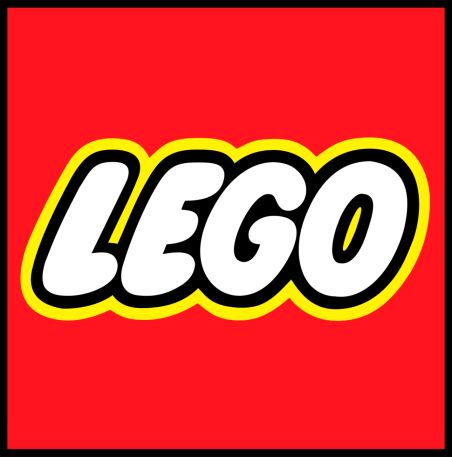Are you a fan of LEGO? Do you remember the first time you saw the iconic LEGO logo? The LEGO logo has become a symbol of creativity and imagination for generations of children and adults alike. The LEGO company has been around for over 80 years, and the logo has undergone many changes during that time.
The LEGO logo is instantly recognizable with its bright colors and bold lettering. The company’s founder, Ole Kirk Christiansen, came up with the name LEGO from the Danish words “leg godt,” which means “play well.” The logo has evolved over time, with the first official logo featuring a solid and bold wordmark in capitals, written in black and used across all business papers and stamps. The lettering was done in a stylized serif typeface with thick straight lines and quirky diagonal serifs.
Over the years, the LEGO logo has become a symbol of creativity and imagination. The company has used the logo to promote its products and build its brand. The LEGO logo has also become a cultural icon, appearing in movies, TV shows, and video games. Whether you are a fan of LEGO or just appreciate good design, the LEGO logo is sure to catch your eye and inspire your imagination.
History of the Lego Logo
The Lego logo has a long and interesting history that spans over 90 years. The logo has gone through many changes since it was first created in 1934. Here is a brief overview of the Lego logo’s evolution throughout the years:
- 1934: The first Lego logo was created, featuring the word “LEGO” in black letters on a white background.
- 1946-1950: The logo became more colorful during this time, with the addition of orange and black colors. The colors were meant to represent energy, joy, and confidence.
- 1953-1955: An experimental logo was developed during this time in two color schemes. They both had a red word mark in a geometric sans-serif font, with one featuring a red in white outline, with the other being the red word mark on a yellow background.
- 1963-1972: The Lego logo was updated to feature a new font that was more modern and sleek. The letters were also made bolder and more prominent.
- 1973-1998: The logo was updated again during this time to feature a more playful and fun design. The letters were made more rounded and the colors became brighter and more vibrant.
- 1998 to present: The Lego logo was updated once again in 1998 to feature a more streamlined and modern design. The colors were simplified to just red, yellow, and black, and the font was made bolder and more prominent.
Overall, the Lego logo has evolved significantly over the years, but it has always remained true to its playful and fun nature. The logo has become a symbol of creativity, imagination, and endless possibilities, and it continues to inspire people of all ages around the world.
Design Elements of the Lego Logo
https://www.youtube.com/watch?v=GcwdsENMzKk&embed=true
When it comes to the Lego logo, there are several design elements that make it instantly recognizable. These design elements include color, typography, and symbol. Let’s take a closer look at each of these design elements.
Color
The Lego logo features a bold and vibrant color scheme that is instantly recognizable. The primary color used in the logo is red, which is a bold and energetic color that is associated with passion, excitement, and creativity. The red color is also used to represent the bricks that are used to build Lego creations.
In addition to red, the Lego logo also features white and black. These colors are used to create contrast and balance in the logo design. The white color is used to create a clean and modern look, while the black color adds depth and dimension to the logo design.
Typography
The typography used in the Lego logo is a bold and simple sans-serif font. The font is designed to be easy to read and instantly recognizable. The font is also designed to be playful and fun, which reflects the spirit of the Lego brand.
The Lego logo also features a unique spacing between the letters, which creates a sense of movement and playfulness. This spacing is designed to mimic the way that Lego bricks fit together to create new and exciting creations.
Symbol
The symbol used in the Lego logo is a simple and iconic image of a Lego brick. The brick is designed to be instantly recognizable and is a symbol of creativity, imagination, and playfulness. The brick is also used to represent the building blocks that are used to create Lego creations.
The Lego logo also features a unique placement of the symbol, with the brick sitting above the word “Lego”. This placement is designed to create a sense of balance and harmony in the logo design, while also highlighting the importance of the Lego brand.
Overall, the design elements of the Lego logo are simple, bold, and instantly recognizable. The color, typography, and symbol work together to create a logo that is playful, fun, and reflective of the Lego brand.
Evolution of the Lego Logo
When you think of LEGO, one of the first things that comes to mind is their iconic logo. Over the years, the LEGO logo has undergone several changes, each reflecting the company’s growth and evolution. In this section, we will take a closer look at the evolution of the LEGO logo.
First Logo
The very first LEGO logo was created in 1934, shortly after the company was founded. The logo featured the word “LEGO” in black letters on a white background. The letters were spaced out and featured a serif font, giving the logo a classic and timeless feel.
Current Logo
The current LEGO logo has undergone several changes since the first logo was created. The most recent version of the logo features the word “LEGO” in bold, uppercase letters. The letters are arranged in a rectangular shape, with each letter connected to the others. The logo is typically displayed in bright primary colors, including red, yellow, and blue.
Over the years, the LEGO logo has become one of the most recognizable logos in the world. The logo’s simple and timeless design has helped to establish LEGO as a brand that is synonymous with creativity, fun, and imagination.
In conclusion, the evolution of the LEGO logo is a testament to the company’s commitment to innovation and growth. From its humble beginnings to its current status as a global brand, the LEGO logo has remained a constant symbol of creativity and imagination.
Impact and Recognition of the Lego Logo
The Lego logo is a globally recognized symbol that has played a significant role in the company’s success. The logo has become synonymous with the brand, and its impact can be seen in various ways.
Firstly, the Lego logo has helped to establish the brand as a leader in the toy industry. The logo’s design is simple, yet effective, and has become instantly recognizable to people of all ages. This recognition has helped to establish Lego as a household name, and the logo is now synonymous with quality, creativity, and innovation.
Secondly, the Lego logo has played a crucial role in the company’s marketing efforts. The logo’s design has been used in various advertising campaigns and has helped to promote the brand’s products to a global audience. The logo’s bright colors and playful design have helped to make Lego’s products stand out from the competition, and its impact can be seen in the brand’s continued success.
Finally, the Lego logo has become an iconic symbol of creativity and imagination. The logo’s design is based on the brand’s core values of playfulness and creativity, and it has become a symbol of these values to people around the world. The logo’s impact can be seen in the millions of people who have used Lego products to express their creativity and imagination.
In conclusion, the Lego logo has had a significant impact on the brand’s success and recognition. Its simple yet effective design has helped to establish Lego as a leader in the toy industry, and its playful design has become a symbol of creativity and imagination to people around the world.
Trivia and Interesting Facts About the Lego Logo
Are you a fan of Lego? Do you want to know more about the iconic Lego logo? Here are some fascinating facts about the Lego logo that you might not know:
- The Lego logo was designed in 1934 by Ole Kirk Christiansen, the founder of Lego. The logo has undergone several changes over the years, but the basic design has remained the same.
- The word “Lego” is a combination of two Danish words, “leg godt,” which means “play well.” The name was chosen because the company’s main product was wooden toys for children.
- The Lego logo features the word “Lego” in a bold, sans-serif font. The letters are arranged in a rectangular shape with rounded corners, and the “o” is slightly tilted.
- The current Lego logo features the word “Lego” in white letters on a red background. The red color was chosen because it is bright, bold, and eye-catching. The white letters stand out against the red background, making the logo easy to read and recognize.
- The Lego logo has been used on all of the company’s products, including Lego sets, Lego bricks, and Lego minifigures. The logo is also used on the company’s packaging, advertising, and marketing materials.
- The Lego logo is one of the most recognized logos in the world. It is instantly recognizable and has become a symbol of creativity, imagination, and playfulness.
- The Lego logo has been featured in several movies and TV shows, including “The Lego Movie,” “The Lego Batman Movie,” and “The Lego Ninjago Movie.” The logo has also been used in video games, theme parks, and other merchandise.
- The Lego logo has inspired many people to create their own versions of the logo. There are countless fan-made versions of the Lego logo, including versions made out of Lego bricks, drawings, and digital designs.
Overall, the Lego logo is a timeless symbol of creativity, imagination, and playfulness. Whether you are a fan of Lego or just appreciate good design, the Lego logo is sure to catch your eye and inspire you to create something amazing.
Angela Irwin is a branding and design enthusiast with a Bachelor of Fine Arts in Graphic Design from Meadowbrook College. As a writer at Logocreator.io, she shares her expertise on logo design, graphic trends, and effective branding strategies, helping businesses create impactful visual identities.



